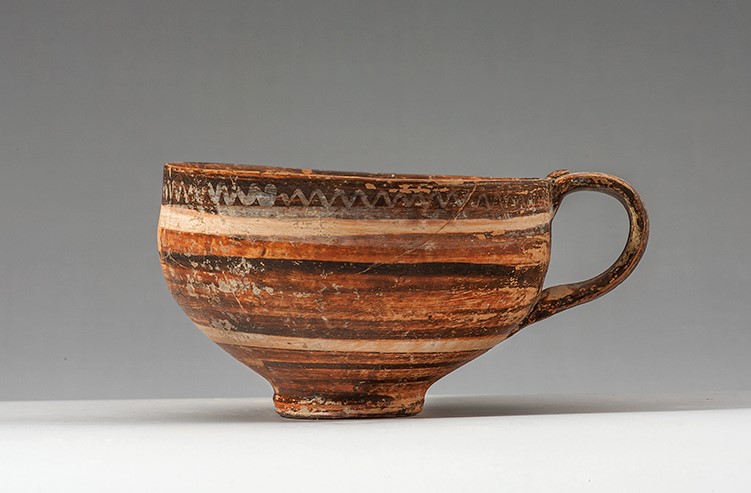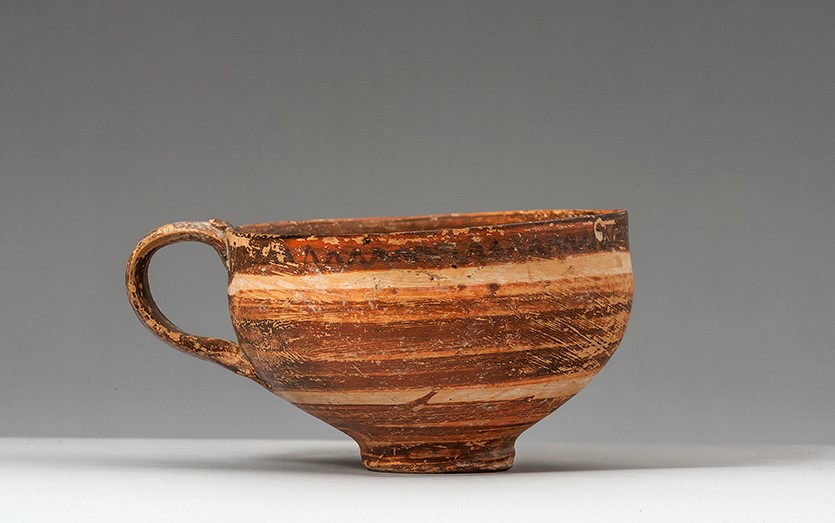Title: Minoan Cup - 1970.10
Acquisition number: 1970.10
Acquisition source or name: Folio Fine Art Ltd, London
Acquisition year: 1970
Owner type: ANU Classics Museum
Price: $224.00
Author or editor: J.R. Green
Culture or period: Late Minoan I A
Date: 1550 - 1500 BC.
Date century or Timeline (notional): 1550 to 1500
Material: Clay
Object type: Vessels - Cup/mug
Dimensions: 108mm (w) × 61mm (h)
Origin region or location: Greece
Origin city: Crete
Display case or on loan: 1
Collection history: Purchase
Keywords: Bronze Age, Late Minoan I A, Minoan, Crete
Folio Fine Art Ltd (London), Catalogue 74 (July 1970) no. 732; Charles Ede, Collecting Antiquities (London 1976) 4, no. 4 (ill.); J.R. Green with B. Rawson, Catalogue of Antiquities in the Australian National University, A.N.U., Canberra, 1981, 17.
1970.10
Minoan Cup
Purchased. Ht 6.1cm; max. diam. 10.8cm.
A fragment of the upper wall and rim has been broken and rejoined; there is no repainting. Smooth pale buff clay. The offset base is flat underneath; strap handle with a pellet on top. Streaky mid- to dark-brown paint.
The inside is entirely painted and the brush-marks are clearly visible. The inner and outer faces of the handle are also painted. On the outside there is a band of paint at the lip and then two broad bands to the foot. The outer part of the underside of the foot is also painted. The decoration was enlivened with added white: there are bars of white on the handle (now mostly faded), a zigzag band over the brown at the lip and then a broad band below that overlaps the reserved zone.
Late Minoan Ia; 1550-1500 bc. This is a characteristic piece of LMIa pottery. One may note the thin walls, the smooth hard clay and the use of added white over the brown paint. This use of added colour was inherited directly from the light-on-dark tradition of the Middle Minoan period but it passed out of fashion with LMIb.
For a reliable treatment of Late Minoan pottery see M. Popham, “Late Minoan Pottery, A Summary”, Annual of the British School at Athens (1894/5-) 62, 1967, 337-352; also the relevant section of P.P. Betancourt, The History of Minoan Pottery (Princeton 1985). There are useful illustrations of LMIa material, some in colour, in the publications of the Thera excavations.
Folio Fine Art Ltd (London), Catalogue 74 (July 1970) no. 732; Charles Ede, Collecting Antiquities (London 1976) 4, no. 4 (ill.); J.R. Green with B. Rawson, Catalogue of Antiquities in the Australian National University, A.N.U., Canberra, 1981, 17.
1970.10
Minoan Cup
Its decoration enlivened with added white paint
At this period the Minoan civilization of Crete was still powerful in the Mediterranean. By 1450 BC, however, the Mycenaeans had taken over Crete, and almost all the Minoan palaces had been burned to the ground.
Late Minoan I A / Crete / 1550 - 1500 BC
Folio Fine Art Ltd, London, Catalogue 74/732; stg 105

